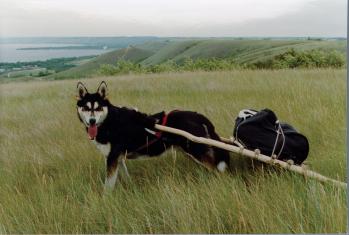
The travois (from a French word akin to travail, to work) is a wooden load-bearing frame fastened by a leather harness to a dog or horse. The basic dog travois consists of two aspen or cottonwood poles notched and lashed together at one end with buffalo sinew; the other ends rest splayed apart. Cross-bars are lashed between the poles near the splayed ends, and the finished frame looks like a large letter A with extra cross-bars. The apex of the A, wrapped in buffalo skin to prevent friction burns, rests on a dog’s shoulders, while the splayed ends drag over the ground. Travois, used by all Plains Indian nations, were once commonplace throughout the Plains area of what is now Saskatchewan. They are unique to North America: they are not known to have existed in other grassland realms such as the steppes of Europe or the pampas of South America. Travois are ideally suited to their environment: over native grassland the dragging ends move silently and almost without friction; but outside of grasslands the contraption is not very useful, for bush or gullies are impassable.
First Nations women both built the travois and managed the dogs, sometimes using toy travois to train the puppies. Buffalo meat and firewood were typical travois loads. Dogs can tack up and down grassy hill slopes and ford shallow rivers with a travois; but temperature is a serious constraint on travois work, for on warm days dogs overheat easily. Sadly, the original Plains Indian dogs that once pulled travois can no longer be found, as they have mixed with European dogs. In historic times Plains Aboriginal peoples constructed much larger versions of the dog travois and hitched them to horses. Horse travois allowed the transport of the increased material wealth accumulated by some First Nations skilled in the mounted buffalo hunt; children or ill adults could ride on the horse travois load rack as well. The rack ride is smooth, but riding a horse pulling a travois has a few disadvantages: the rider’s legs hang uncomfortably over the travois poles alongside the horse’s flanks, and control over the horse is diminished by the loss of thigh-to-horse contact.
Norm Henderson